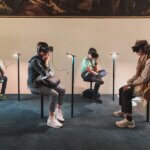New research into the use of videoconferencing and the increasingly common practice whereby companies oblige employees to keep their cameras on at all times, supposedly to facilitate better communication and team bonding, reveals that instead it often makes people tired and isolated.
Needless to say, the research has attracted attention, given the huge number of people working from home during the pandemic, and who in many cases will continue to do so. What’s more, we’re holding more and more meetings via videoconference, along with conversations that would once have taken place by telephone — for example, with journalists — all in search of a supposedly more authentic encounter.
In the academic world, the requirement to keep the camera on at all times during the working day is now ubiquitous. For a teacher like myself, there are few things more disagreeable than speaking to a screen full of black boxes with names behind which you assume there are people, even though you can’t see the effect of your words on them. More challenging still is the liquid learning environment — which allows students to either attend class in person or from home — with the omnipresent fear that when you get to the classroom there’s nobody there. Speaking to an empty classroom borders on the surreal. Thus, students must, if connecting via videoconferencing, keep their camera on, if only to prevent them from logging off two minutes after the session has begun. Appealing to the empathy of one’s interlocutor is one solution: in a videoconference between two participants, it is a matter of politeness to connect the camera if the other participant keeps theirs connected, a responsibility that can diminish if there are more participants.
I have always tended to give my students freedom and appeal to their sense of responsibility when deciding whether they want to keep their camera on or off, simply asking them, out of courtesy, not to leave me talking to an empty screen, and it has generally worked quite well, considering that my students are adults and that I have always treated them as such. However, it must be understood that, on many occasions, what for the teacher is a session, for the student is just another in a chain of sessions, and the idea of keeping that camera on for several hours can be very tiring.
Zoom fatigue is a thing: it is caused by prolonged use of a computer’s camera screen. Staring at your own image for hours on end is not natural, although there are remedies. In the course of a normal day, we meet with other people and maintain eye contact with them, but we are not seeing each other at the same time. This permanent reflection of our own image, in addition to being distracting, is particularly important for two specific categories of employees: women and new hires, where the camera increases the cost of presenting themselves to the group, in the case of women due to gender stereotypes associated with the idea of “being presentable at all times”. In the case of recent hires, the camera increases the stress arising from the need to appear as active and contributing members of a newly arrived group.
In the study, employees were randomly assigned to two groups, one of which was asked to keep the camera on at all times and one of which was not. The result is a direct and significant correlation between camera use and fatigue, while, in contrast, the number of hours employees spent video conferencing was not.What if working from home could be different to how it’s been until now?I’ve been using this Distributed Work’s five levels of autonomy model since I saw it two months ago on the page of Matt…medium.com
The logical evolution in distributed work environments will be the use of asynchronous work tools (instant messaging, e-mail, document sharing, etc.), reserving videoconferencing for specific occasions. Managing asynchrony reflects the level of maturity of organizations in developing distributed work environments, and allows employees to manage it in much less stressful ways. This is something the business and academic world will need to take into account in the post-pandemic world.






























